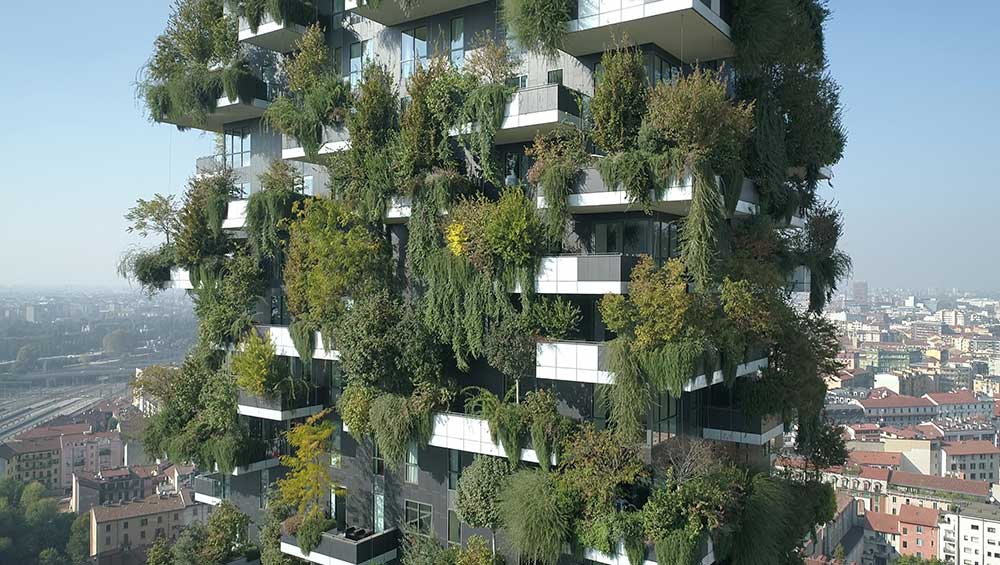
Stefano Boeri, Bosco Verticale, Milan, 2014. © Stefano Boeri Architetti. Photo: The Blink Fish, 2018.
Vitra Design Museum, Weil am Rhein
25 March – 3 October 2023
by VERONICA SIMPSON
Gardening, when it goes well, can feel like a kind of magic. With the right combination of skill, luck and timing, along with the key elements in the right quantities – sun, rain and good soil – something beautiful, or edible and delicious emerges. The resulting joyful profusion of flowers, fruit or vegetables can appear almost miraculous, no matter how many times you witness it.
Following an extended period confined to our homes or neighbourhoods, we have all become a little more appreciative of the available greenery. This, and the escalating climate emergency have made plant care a priority for many people. Gardening or spending time in gardens or parks have never been so popular across all ages and demographics. Which is why the Vitra Design Museum has scheduled a show exploring the meaning and purpose and diverse uses of gardens through the ages.
“The garden has always been a paradise and a place of refuge,” declares the introductory panel. Although gardens started out as a luxury few could afford, this is the first exhibition that looks not just at the evolving aesthetics of the garden, but also the way in which gardening – the collection as well as the dispersal and arrangement of plants – has played its part in various political and social movements; designing with nature, indeed. As the curators go on to say: “The form that people give to their gardens always reveals their own relationship to nature – and sometimes that of entire cultures and eras”; even a neglected back garden, filled with weeds and rusting car parts, says something about the attitude to nature of those who live there.
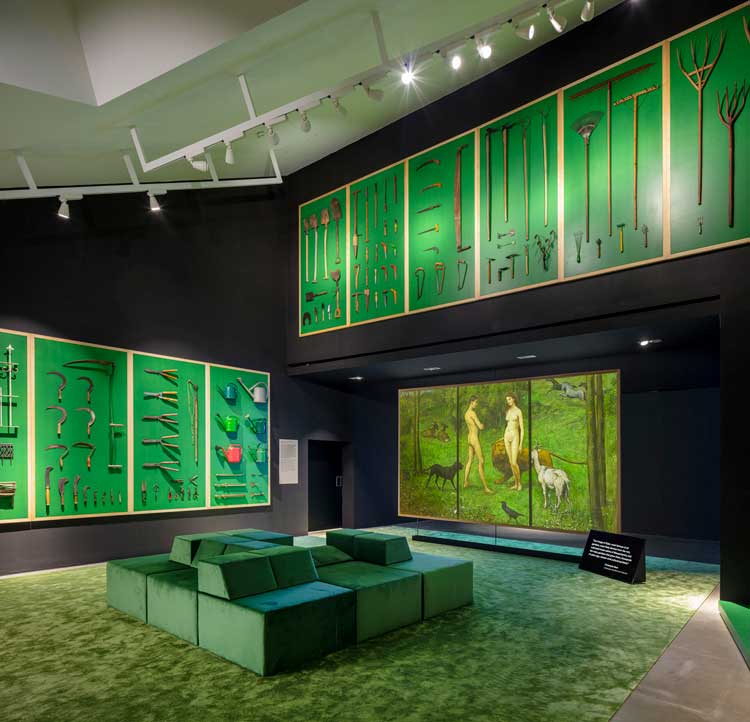
Garden Futures: Designing with Nature. © Vitra Design Museum
Photo: Ludger Paffrath.
Garden Futures: Designing with Nature traces this relationship across the last 2,000 years, albeit majoring on the last 100. The exhibits start with the earliest known formal and organised gardens, unveiled in filmic form, in gallery no 1, its walls and floor decorated with swags of lush fabrics in grassy green, while across three screens an overlapping cycle of paintings, etchings, drawings and photographs emerge, documenting shifts in garden aesthetics, from the mythological and biblical through the medieval and monastic to the co-operative. Above the screen and on the surrounding walls are displays of various tools of the trade. Along one wall is a collection of vintage garden furniture – lest we forget, the Vitra Design Museum is a working campus of furniture creation, funded by and dedicated to the appreciation and sale of pieces conceived by 20th-century greats such as Charles and Ray Eames and Jean Prouvé.
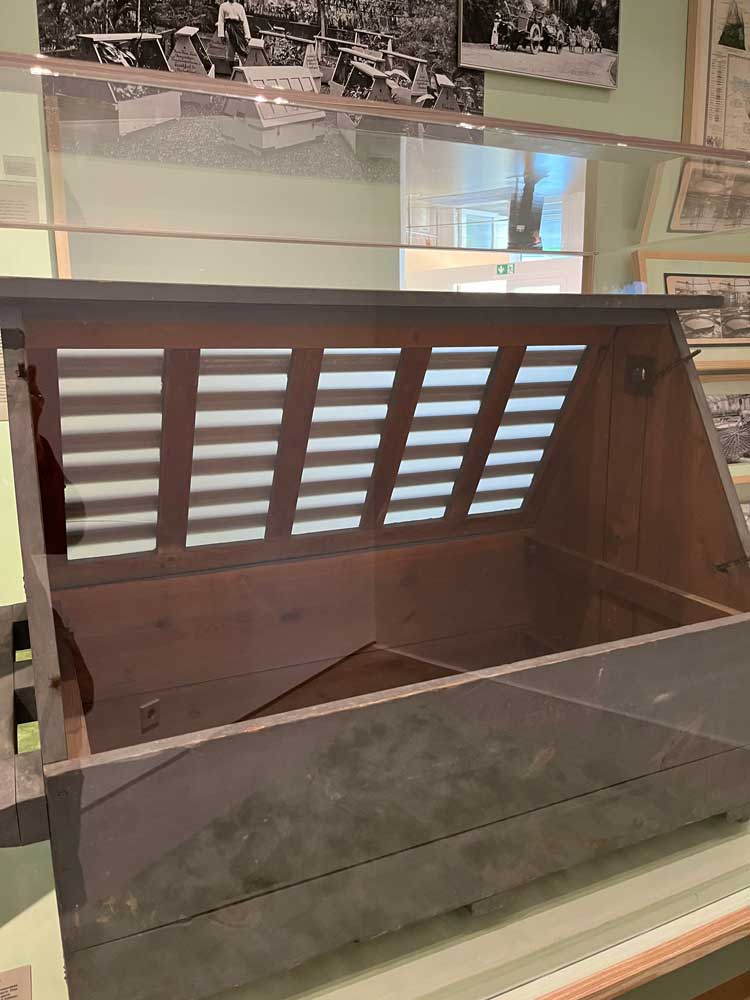
Wardian case devised for transportation of live plants to and from the colonies by Nathaniel Bagshaw Ward. Photo: Veronica Simpson.
In the following gallery, we are invited to walk around assorted large vitrines, exploring the ways in which gardens and plants have been deployed within wider political and social movements and projects. It starts, of course, with colonialism. To this end, we are presented with a “Wardian” case, a portable wooden and glass terrarium designed by the surgeon and amateur naturalist Nathaniel Bagshaw Ward (1791-1868) for transporting live plants to and from the colonies. This endless collection, categorisation and dissemination of plant species around the world, as the panel pithily summarises, “not only had a significant impact on the global environment, but also became an accomplice to colonial exploitation and an accessory to complex ecological transformations”. Not all transplanted species thrive in foreign climes – while others thrive rather too well, invading and eclipsing native varieties.
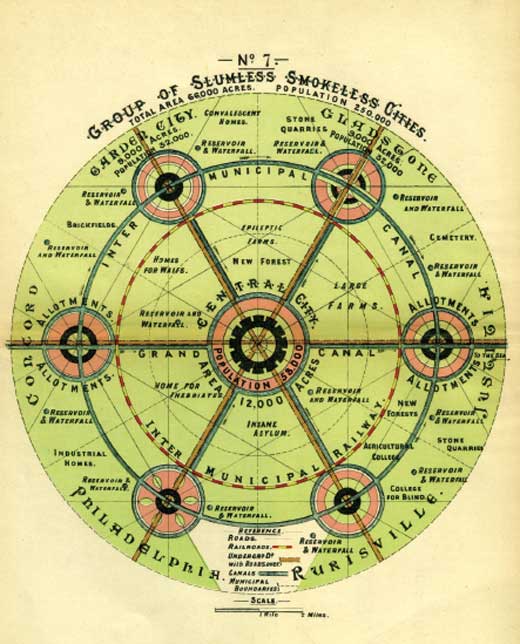
Ebenezer Howard, Diagram of the garden city concept, published in his book To-Morrow: A Peaceful Path to Real Reform, 1898. © Town and Country Planning Association.
Further into the gallery, we have more positive examples of gardens being used as testing grounds for new ideas, such as healthy living, thanks to Ebenezer Howard’s post-first-world-war proposal for garden cities, as a far more salubrious alternative to dense, inner-city housing. Said to combine the best of urban and rural life, the plan was typified by spacious street layouts framing modest houses or apartments with generous gardens. Sadly, even this had its drawbacks: in theory, it would lead to a profusion of fresh air and greenery, but, in practice, it gave birth to the eventual samey dreariness – and car-centric lifestyles - of suburban sprawl.

Guerrilla gardening display, including US pioneer Liz Christy (pictured top right). Photo: Veronica Simpson.
While the suburbs are synonymous with urban expansion in the US, they also spread rapidly into planning practice in the UK, Germany and Australia. But while some folks sought leafier residential idylls, cities have continued to densify and it wasn’t long before the majority of their inner-city population had little access to nature beyond an occasional park. Which brings us to the “guerrilla gardeners” of the 1970s and 80s. In the vitrine about gardening activists, we learn about Liz Christy, a pioneer of the practice, who threw “seed green-aids” into vacant lots around New York and planted sunflower seeds and flower boxes on the window ledges of abandoned buildings. The movement she launched, Green Guerrillas, thrives to this day, as does that spirit of greening as an act of civil disobedience.
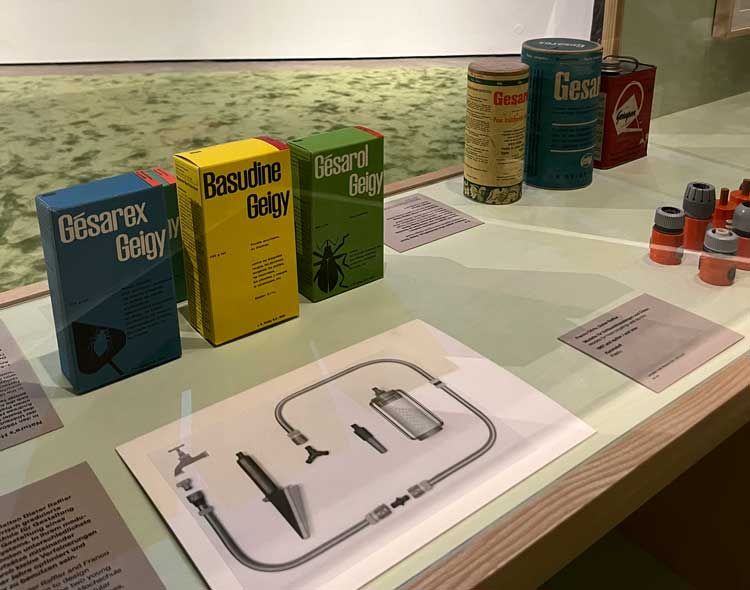
Weed killers and pest control vitrine with vintage examples. V Simpson. Photo: Veronica Simpson.
The mid-century American dream of suburban homes fringed with extensive gardens (and pools) also gave rise to the widespread use of pesticides, weed killers and a host of other chemicals that are represented in one vitrine emblazoned with a lifestyle-magazine image of glamorous young professionals on recliners against the perfect lawn – echoing the adverts that promised quick results without the hard labour. Original canisters of these toxic products, with their pop-art packaging, are displayed.
However, the enduring emotional appeal of the garden – even under the toughest circumstances – is most poignantly evoked in the photographs of Henk Wildschut, who has documented refugee encampments and their forlorn but touching displays of proprietorial “garden” design.
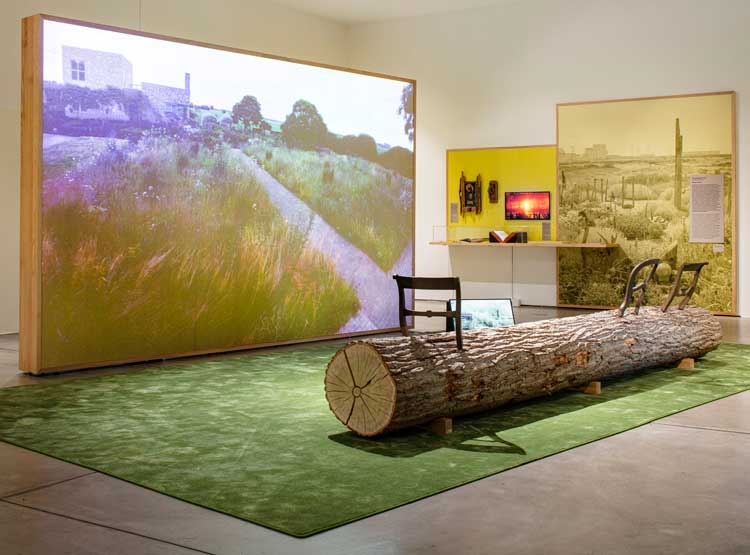
Garden Futures: Designing with Nature, Gallery 3, film showing iconic gardens through the seasons. In the foreground Jurgen Bey’s Tree-trunk bench, 1998. © Vitra Design Museum, Photo: Ludger Paffrath.
We are, however, allowed to bathe in the pure sensory pleasure of gardening, of watching the plants and seasons change, thanks to a large screen installation in the third gallery. Here, time-lapse photography rolls us through the changes in a number of landmark gardens, including that of the Dutch designer Piet Oudolf (whose 2021 contribution to Vitra Design Museum’s flora and fauna sits just a few hundred yards away). A rather picturesque, fake log is provided as seating, on green velour carpeting. This is the feel-good gallery. Over in the corner, a display tells us how Weleda, the Swiss plant-based cosmetics company (and a sponsor of this show), has been harnessing the power of plants, sustainably and organically, since 1921, working in balance with nature.
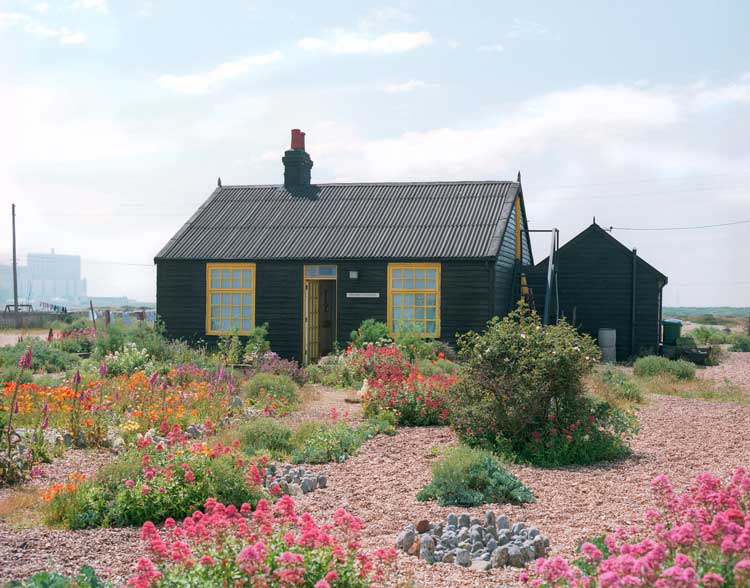
Derek Jarman, Prospect Cottage Garden at Dungeness, Kent, UK, from 1986. Photo: Howard Sooley, 1993.
Another display is dedicated to the extraordinary, sculptural garden created by the UK film-maker Derek Jarman, on the Kent coast, near Dungeness. Since his death, in 1994, his house and garden has become a place of pilgrimage for many a nature and film-lover, and was recently transformed into a permanent public museum, after a £3.5m crowdfunding campaign led by the Art Fund. On a far wall, there is more inspiration from the other side of the world: Kuala Lumpur is home to a vibrant community of collective gardeners, whose response to the city’s high-speed and hectic densification has been to claim unused land for their own garden activism projects, starting with the first, the Kebun-Kebun Bangsar (Bangsar gardens), which opened in 2017.
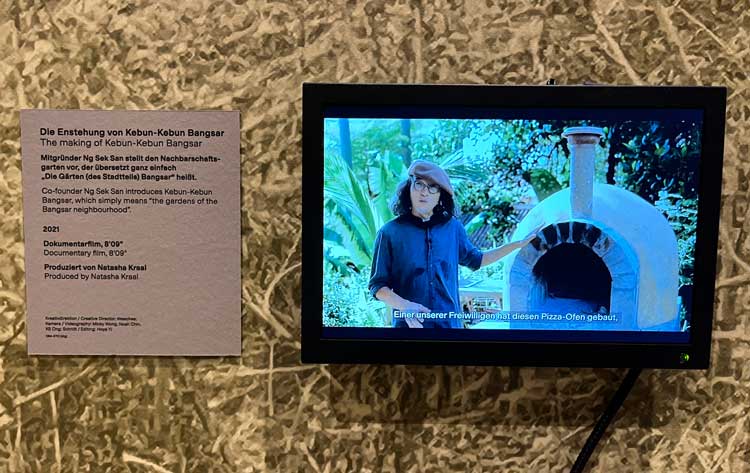
Exhibit on the making of Kuala Lumpur's Kebun-Kebun Bangsar community garden, including this 2021 documentary. Photo: Veronica Simpson.
In the last gallery, upstairs, the entire floor is laid out in that verdant green velour, part of it lapped by a luscious woven wool rug festooned with flowers, which continues up the adjacent wall (Alexandra Kehayoglou’s Meadow, 2023). This room hosts a picturesque assortment of speculative projects and artworks demonstrating a literal approach to “designing with nature”, including one initiative, from designers Alice and Gavin Munro, who have devised a way to shape saplings into furniture – each one an individual work of art and nature. They call this range Full Grown, and even the luxury brand Louis Vuitton is a fan, acquiring one of these “carbon sink sculptures” for its collection.
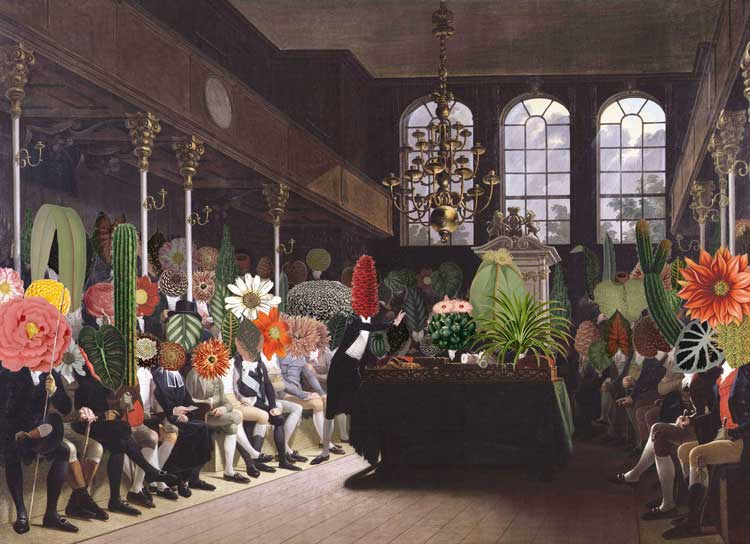
Céline Baumann, Parliament of Plants, 2020. © Studio Céline Baumann.
Elsewhere, there is a collage by Céline Baumann featuring plant-human hybrids sitting at a multi-species conference (Parliament of Plants, 2019), to illustrate the idea that plants, and other species, should have rights in the same way that people do. There are also multiple displays detailing successful legal actions on behalf of non-human entities, including New Zealand’s Whanganui River, which was granted legal rights in 2017.
Alongside these exciting and ambitious approaches to reimagining our relationship to nature, it is great to see UK artist Alexandra Daisy Ginsberg’s Pollinator Pathmaker project. Ginsberg was commissioned by the Eden Project to create an artwork that would highlight the catastrophic loss of habitats that were supportive of pollinators across the UK. She came up with an infinitely adaptable planting design that prioritises the plants that pollinators love, regardless of their aesthetic appeal, and also a digital tool by which everyone can have their own bespoke “pollinator pathmaker” to suit whatever patch of land, park or allotment to which they have access. From the Eden Project’s garden to one planted in Hyde Park last summer (for the Serpentine Gallery’s Back to Earth show), and a growing number of other private and public initiatives, Ginsberg hopes to use her burgeoning plant and pollinator knowledge and technological skills to co-create “the world’s first climate-positive artwork”.
This comprehensive and intensively researched show is accompanied by a handsome catalogue and one of the most enticing programmes of talks and engagements that I have seen by this, or any other, museum, from a talk by the Italian architect Stefano Boeri about his successful Vertical Forest apartment design to a “Queer Nature” walk by Baumann.
Whether simply marking an existing shift or propelling us forward towards one, this exhibition – which travels on to the Het Nieuwe Instituut in Rotterdam and the V&A Dundee in 2024 – could do much to fuel a new vision of how we can live in better balance with nature. I would be tempted to agree with the exhibition text, which declares: “Today, in the face of climate crisis, globalisation and food insecurity, the garden has again become a laboratory for new concepts of sustainability and social justice, a place of hope and promise.”